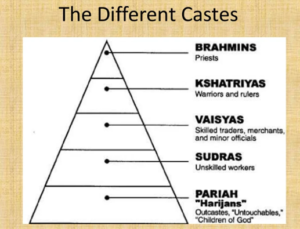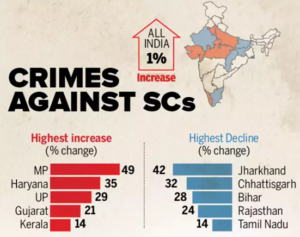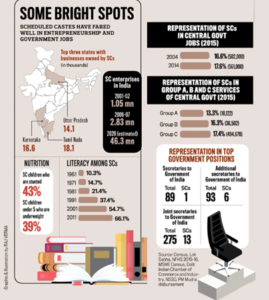De-Casting ourselves.
Relevance
- GS Paper 2 Issues and Policies related to Scheduled Caste.
- GS Paper 3 Role of Family Society and Educational Institutions in Inculcating Values.
- Tags: #Ragging #dalits #Reservation #InclusiveIndia #SabkaSaathSabkaVikas #IndianExpressEditorialAnalysis.
Why in the News?
An 18-year-old first-year student at Jadavpur University died on August 10, 2023, after allegedly being ragged by senior students. Dalit students are not only subjected to physical and verbal abuse during ragging, but their identities are weaponized against them.
Evolution of Caste in India
| Religious theory | Occupational theory | Political theory |
| · The caste system was created by Brahma, the Hindu god of creation.
· Brahma is said to have created the four Varnas (or castes) from different parts of his body · Brahmins (priests) from his head · Kshatriyas (warriors) from his arms · Vaishyas (merchants) from his thighs · Shudras (laborers) from his feet. |
· The caste system originated from the different occupations that people performed.
· Brahmins were the priests and scholars · Kshatriyas were the warriors and rulers · Vaishyas were the merchants and farmers · Shudras were the laborers. |
· The caste system was created by the Brahmins to maintain their power and influence.
· Brahmins were the only caste that was allowed to read and write · They controlled the education system. · They also controlled the temples and religious rituals · This gave them a great deal of power over the other castes. |
Factor lead to evolution of Caste/Jatis
Vedic Period (1500–500 BCE)
- During the Vedic period, the initial seeds of the caste system began to appear.
- The society was categorized into distinct groups based on their professions and skills.
- These groups, referred to as “Varnas,” encompassed Brahmins (priests and scholars), Kshatriyas (warriors and rulers), Vaishyas (traders and farmers), and Shudras (laborers and service providers).
Emergence of Jatis
- Over time, these Varnas fragmented into numerous smaller groups called “JATIS.”
- Jatis were primarily occupational groups and became more rigid and hierarchically structured, eventually forming the basis for the caste system.
- Birth became an important determinant of one’s social status.
Influence of Religion and Scriptures
- Hindu religious texts, such as the Manusmriti, reinforce and codify the caste system, assigning specific roles and duties to each caste.
- The Manusmriti, emphasized the importance of social order and segregation between castes.
Influence of Invasions and Migration
- Invasions and migrations by different groups into the Indian subcontinent also played a role in shaping the caste system.
- New groups were absorbed into the existing framework, leading to the proliferation of jatis.
- Gupta period (circa 4th to 6th century CE) in ancient India, Caste system became more rigid during this period, with stricter rules governing social interactions and occupations based on caste, portrayal of caste-related themes in artistic and literary works
Economic and Political Factors
- Caste divisions were further cemented by economic factors, as certain castes gained control over resources and opportunities.
- The caste system also became a tool for maintaining social order and control, as those in power sought to ensure their dominance.
British Colonial Rule
- The British colonial administration further institutionalized and codified the caste system.
- Measures like 1871Caste Census, Communal Award (1932) etc
Social Norms and Prejudices
- Social norms and prejudices related to purity, pollution, and inter-caste marriages contributed to the reinforcement of the caste system.
- These norms were upheld within communities and perpetuated the hierarchical structure.
Challenges Faced by Dalits
Caste-Based Discrimination and Violence
- Caste-based discrimination remains a pervasive issue, affecting Dalits in various aspects of their lives.
- From denial of basic human rights to physical violence and social exclusion, Dalits often face discrimination solely based on their caste identity.
Untouchability Practices
- Despite being officially abolished, untouchability practices still persist in many parts of the country.
- Dalits are often excluded from social and religious activities, denied access to public spaces, and subjected to segregation.
Economic Disparities
- Dalits often occupy the lowest rungs of the economic ladder.
- Limited access to quality education, employment opportunities, and resources keeps them trapped in a cycle of poverty, making economic mobility challenging.
Lack of Access to Education
- Dalit children continue to face hurdles in accessing quality education.
- Discrimination by teachers and peers, inadequate infrastructure, and a lack of support systems contribute to low enrollment and high dropout rates.
Limited Political Representation
- While there have been improvements in political representation, Dalits are still underrepresented in elected bodies and leadership positions.
- This affects their ability to influence policies that directly impact their lives.
Land Ownership and Agriculture
- Landlessness is a significant issue among Dalits, hindering their economic stability and upward mobility.
- Access to agricultural land is often denied, affecting their participation in the agrarian economy.
Access to Healthcare and Sanitation
- Dalits often face discrimination in healthcare facilities, leading to inadequate access to medical services.
- Additionally, lack of proper sanitation facilities disproportionately affects Dalit communities.
Social Exclusion and Stigmatization
- Dalits frequently face isolation and exclusion from mainstream society due to deep-rooted social prejudices.
- Stigmatization and derogatory labeling continue to limit their opportunities and interactions.
Violence Against Women
- Dalit women face compounded discrimination due to their caste and gender.
- They are often victims of violence, including sexual assault, with limited avenues for seeking justice and support.
Inadequate Legal Protection
- While legal measures are in place to protect Dalits from discrimination and violence, the implementation of these laws often falls short.
- Many cases go unreported or unresolved due to systemic biases.
Caste Identity and Denial
- Society often overlooks the influence of caste. Denying caste’s impact erases experiences and stories.
Caste Realities and Violence
- Caste-related incidents underline casteism’s persistence. Violence, suicides, and bias stem from caste identity.
Addressing the Menace of the Caste System: Initiatives and Approaches by the Indian Government
Constitutional Measures
- Abolition of Untouchability: The Indian Constitution, under Article 17, abolished “untouchability” – a practice rooted in the caste system that subjected certain groups to social exclusion and discrimination.
- Reservations: Articles 15(4) and 16(4) of the Constitution allow for the provision of reservations in educational institutions and public employment for Scheduled Castes (SCs), Scheduled Tribes (STs), and Other Backward Classes (OBCs). Scheduled Caste groups are given 15% reservation in government services and educational institutions.
- Article 243Dprovides for reservation for Scheduled Castes and Scheduled Tribes in Panchayats in the same proportion as the population of Scheduled Castes or Scheduled Tribes in the village.
- Article 243Tpromises the same proportionate reservation of seats in Municipalities.
- National Commission for Scheduled Castes and Scheduled Tribes under Article 338 and 338 A
Legislative measures
- Protection of Civil Rights Act (1955) prohibits discrimination on the basis of caste in public places and institutions.
- Scheduled Castes and Scheduled Tribes (Prevention of Atrocities) Act (1989) provides for stringent punishment for crimes committed against members of the Scheduled Castes and Scheduled Tribes.
- Prohibition of Employment as Manual Scavengers and their Rehabilitation Act, 2013 (MS Act) prohibits the employment of manual scavengers and provides for their rehabilitation.
Welfare Schemes
- National Fellowship for Scheduled Caste Students – Grant scholarships ranging from pre-metric to PhD programs, along with offering coaching to students preparing for advanced studies.
- Ambedkar Post-Matric Scholarship for Economically Backward Class Students: This scholarship provides financial assistance to students belonging to economically weaker sections of OBCs to pursue higher education.
- Deendayal Antyodaya Yojana – National Rural Livelihoods Mission (DAY-NRLM): This mission focuses on poverty reduction and social empowerment of rural households, with a special focus on women from SCs and STs
- Deendayal Antyodaya Yojana – National Rural Livelihoods Mission (DAY-NRLM): This mission focuses on poverty reduction and social empowerment of rural households, with a special focus on women from SCs and STs
- National Scheduled Class Finance and Development Corporation (NSFDC) – Extend financial aid to individuals below the poverty line.
- National Safai Karamcharis Finance and Development Corporation (NSKFDC) – Provide financial assistance to safai karamcharis, manual scavengers, and their dependents.
- Special Central Assistance to Scheduled Castes Sub-Plan (SCSP) – Mandate states and union territories to devise distinct component plans (SCP) and allocate funds for effective plan implementation.
- Scheme of Assistance to Scheduled Castes Development Corporation (SCDC) – Allocate funds to State Scheduled Castes Development Corporations (SCDC) for various initiatives.
- Venture Capital Fund – Foster entrepreneurship within the Scheduled Castes community, managed by the designated agency IFCI Limited.
- Credit Enhancement Guarantee Scheme – Facilitate funding for startup entrepreneurs belonging to Scheduled Castes.
- Babu Jagjivan Ram Chhatrawas Yojna – Establish hostel facilities for students pursuing education from higher secondary to university levels.
- Deendayal Antyodaya Yojana – National Rural Livelihoods Mission (DAY-NRLM): This mission focuses on poverty reduction and social empowerment of rural households, with a special focus on women from SCs and STs
People’s Movement to uplift Dalit Community
The Dalit Camera
- The Dalit Camera is a website and social media platform that documents the experiences of Dalits.
- It aims to raise awareness about the discrimination and violence faced by Dalits.
Bhim Yatra
- Bhim Yatra is a movement that focuses on spreading awareness about social justice, equality, and the rights of Dalits.
- It involves organizing rallies, marches, and public events to address issues related to caste-based discrimination and to empower Dalit communities.
Dalit Literature Festivals
- Various Dalit Literature Festivals have been organized to promote Dalit voices, literature, and culture.
- These festivals provide a platform for Dalit writers, poets, and artists to share their perspectives and experiences.
Walk for De-casting
Reservation and “Merit”
- Debate on reservations and merit, the under-representation of marginalized communities and revisiting reservation policies.
Caste as a Shaping Force
- Emphasizing the imperative of acknowledging how caste identities influence social relationships and opportunities. Denying caste’s influence leads to further radicalization and division.
Quest for Equality
- Recognizing the need for representation beyond political participation. Seeking inclusion in cultural, intellectual, and media spaces.
- Making sure that policies are designed to include everyone, regardless of their caste, religion, gender, or any other social group.
Transitioning from Victimhood to Empowerment
- Encouraging a shift from victimhood to self-empowerment. Acknowledging and addressing distrust while working towards unity.
Reclaiming Histories
- Celebrating the roles of Dalit figures like Jhalkaribai, Uda Devi, Mahabiri Devi, Mangu Ram in the Indian independence movement. Acknowledging erased histories and reclaiming them with pride.
Inclusivity and Trust
- Emphasizing diversity, inclusion, and equity in policies. Addressing distrust and working together for a united society.
- This can be done by ensuring that there is representation from all groups in decision-making bodies, and by making sure that policies do not discriminate against any particular group.
“Sabka Saath, Saabka Vikas and Sabka Prayaas” is a commitment to inclusive development. It is about creating a society where everyone has the opportunity to thrive, regardless of their background. We need to ensure that everyone has a voice in the development process. Building trust is a long and difficult process, but it is one that is essential for creating a more just and equitable society.
Source: Indian Express
Mains Question
Discuss the historical context, socio-cultural implications, and contemporary efforts to address caste based humiliation in Indian society?






